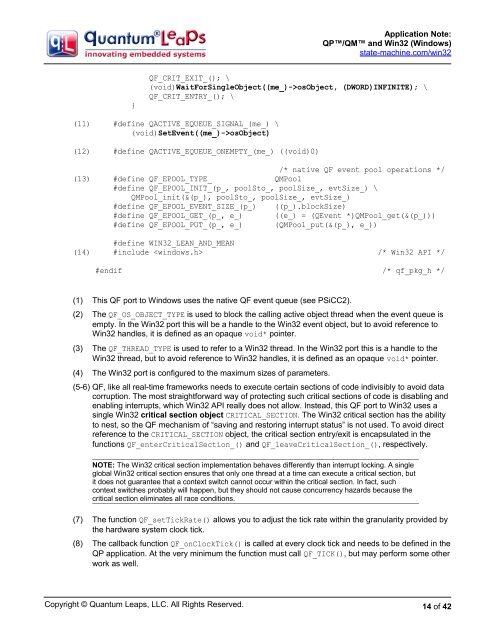QP and Win32 - Quantum Leaps
QP and Win32 - Quantum Leaps
QP and Win32 - Quantum Leaps
- No tags were found...
Create successful ePaper yourself
Turn your PDF publications into a flip-book with our unique Google optimized e-Paper software.
Application Note:<strong>QP</strong>/QM <strong>and</strong> <strong>Win32</strong> (Windows)state-machine.com/win32}QF_CRIT_EXIT_(); \(void)WaitForSingleObject((me_)->osObject, (DWORD)INFINITE); \QF_CRIT_ENTRY_(); \(11) #define QACTIVE_EQUEUE_SIGNAL_(me_) \(void)SetEvent((me_)->osObject)(12) #define QACTIVE_EQUEUE_ONEMPTY_(me_) ((void)0)/* native QF event pool operations */(13) #define QF_EPOOL_TYPE_ QMPool#define QF_EPOOL_INIT_(p_, poolSto_, poolSize_, evtSize_) \QMPool_init(&(p_), poolSto_, poolSize_, evtSize_)#define QF_EPOOL_EVENT_SIZE_(p_) ((p_).blockSize)#define QF_EPOOL_GET_(p_, e_) ((e_) = (QEvent *)QMPool_get(&(p_)))#define QF_EPOOL_PUT_(p_, e_) (QMPool_put(&(p_), e_))#define WIN32_LEAN_AND_MEAN(14) #include /* <strong>Win32</strong> API */#endif /* qf_pkg_h */(1) This QF port to Windows uses the native QF event queue (see PSiCC2).(2) The QF_OS_OBJECT_TYPE is used to block the calling active object thread when the event queue isempty. In the <strong>Win32</strong> port this will be a h<strong>and</strong>le to the <strong>Win32</strong> event object, but to avoid reference to<strong>Win32</strong> h<strong>and</strong>les, it is defined as an opaque void* pointer.(3) The QF_THREAD_TYPE is used to refer to a <strong>Win32</strong> thread. In the <strong>Win32</strong> port this is a h<strong>and</strong>le to the<strong>Win32</strong> thread, but to avoid reference to <strong>Win32</strong> h<strong>and</strong>les, it is defined as an opaque void* pointer.(4) The <strong>Win32</strong> port is configured to the maximum sizes of parameters.(5-6) QF, like all real-time frameworks needs to execute certain sections of code indivisibly to avoid datacorruption. The most straightforward way of protecting such critical sections of code is disabling <strong>and</strong>enabling interrupts, which <strong>Win32</strong> API really does not allow. Instead, this QF port to <strong>Win32</strong> uses asingle <strong>Win32</strong> critical section object CRITICAL_SECTION. The <strong>Win32</strong> critical section has the abilityto nest, so the QF mechanism of “saving <strong>and</strong> restoring interrupt status” is not used. To avoid directreference to the CRITICAL_SECTION object, the critical section entry/exit is encapsulated in thefunctions QF_enterCriticalSection_() <strong>and</strong> QF_leaveCriticalSection_(), respectively.NOTE: The <strong>Win32</strong> critical section implementation behaves differently than interrupt locking. A singleglobal <strong>Win32</strong> critical section ensures that only one thread at a time can execute a critical section, butit does not guarantee that a context switch cannot occur within the critical section. In fact, suchcontext switches probably will happen, but they should not cause concurrency hazards because thecritical section eliminates all race conditions.(7) The function QF_setTickRate() allows you to adjust the tick rate within the granularity provided bythe hardware system clock tick.(8) The callback function QF_onClockTick() is called at every clock tick <strong>and</strong> needs to be defined in the<strong>QP</strong> application. At the very minimum the function must call QF_TICK(), but may perform some otherwork as well.Copyright © <strong>Quantum</strong> <strong>Leaps</strong>, LLC. All Rights Reserved.14 of 42

















